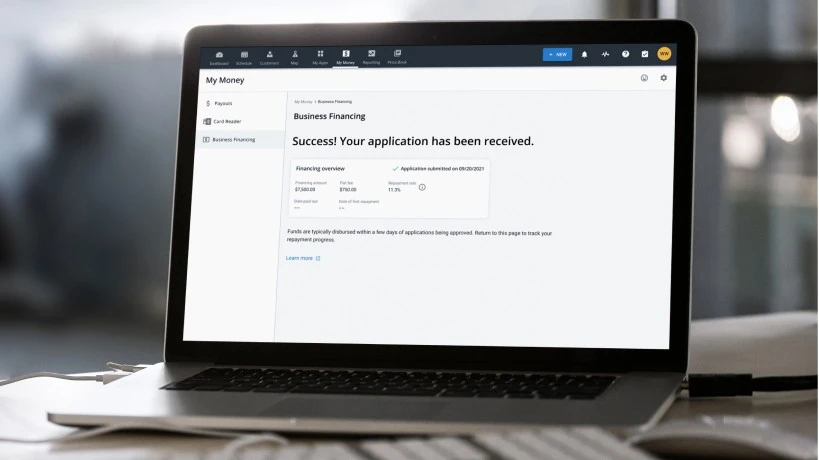
Being a manager is not an easy task. While many make it look easy, the truth is that there is often a lot going on behind the scenes that the average employee is unaware of. In addition to managing day-to-day operations, scheduling employees, and ensuring customers are happy and satisfied with their products and services, it is a lot for anyone to take on. But managers do this each and every day.
Yet, people management is one of the most challenging tasks managers take on. When employees don’t meet expectations despite warnings, improvement plans, etc., sometimes a great leader needs to decide to let someone go. Quite frankly, it’s a topic that no one likes to talk about, but it happens every day.
The team at Housecall Pro has had the privilege of working with many business owners. One of our many conversations is around performance management and how to fire an employee if and when the time comes. We have learned that managers can benefit from some scripts and reassurance that they’re handling the process correctly. In this article, we’ve laid out what you need to know.
Skip to Each Section
- How to Know When to Fire Someone
- How to Let Go of an Employee the Right Way
- How NOT to Fire Someone
- Scripts to Help with Termination Discussions
- What to Do After Firing an Employee
- Need Help with Business Solutions for More Effective People Management?
How to Know When to Fire Someone

Hiring, training, and retaining employees costs businesses a lot of money. According to Indeed, it can cost an average of $722 to $1,4238 per employee just to train them on your policies, procedures, and working standards. And that doesn’t include the cost of finding employees, taking the time to review resumes, conducting interviews, etc.
For those reasons, employers want to protect their investments. Most great leaders will do whatever it takes to keep employees on board once hired. But as we said earlier, sometimes, despite our best efforts, we have to let them go.
Here are some signs that you might need to make the tough decision to fire an employee.
Fall in Performance
Many employees, no matter your industry, will come on board ready and raring to go. They embrace training with vigor and enthusiasm. And their work in the beginning is outstanding. You might need to coach and correct occasionally, but overall, the work is great. It seems like you made a good investment.
But over time, you might notice their performance is beginning to falter. You may hear from customers who were dissatisfied with the person’s work. You take all the steps to help the employee turn things around—you offer coaching, you put them on a performance improvement plan—but things don’t change. Eventually, this leads to warnings, corrective action, and termination.
Poor Cultural Fit
Sometimes, employees are not well suited to your organization’s culture. This can manifest in several ways, such as frequent conflicts with team members, a mismatch in values, or reluctance to adapt to company norms. For instance, if your company prides itself on collaboration and a team-first attitude, an employee who consistently prefers to work alone or undermines group efforts might not be the right fit. These behaviors can disrupt team dynamics and ultimately impact the overall workplace environment.
Not Enough Work
This is an unfortunate situation as not only does it end poorly for the employee, but it also means your business is not generating the revenue that you predicted. Before firing these employees, see if there are other divisions of your business where they could help. And if that’s not an option, you may face a tough decision.
When termination is not performance-based, consider what services you can offer to the employee to help them find their next role. Depending on your industry, you may be able to offer them letters of recommendation to use at a future employer, or perhaps you can provide a referral to another local business that may be hiring.
Poor Attendance
Ultimately, you need employees to show up for the job. They need to be on time and ready to do the job at the start of their scheduled shift. This might mean a warning when they don’t show up once, but multiple no-shows are grounds for termination.
While it is up to you how many consecutive absences you will permit without reason (i.e., a medical situation with a note, death in the family, etc.), the most common threshold is three. You may also choose to fire an employee who is consistently late to work or who consistently punches out early without manager authorization. This information can be easily tracked through your time-tracking tools.
Company Violations
Last but not least, employers can’t tolerate employees who violate company policies or procedures. These work standards and requirements are typically put in place to protect the employee, other employees, and the company’s customers. Before you fire an employee for a company violation, ensure that the employee has access to any employee manual that lists terminable offenses.
This said, some violations can be considered zero-tolerance and demand termination immediately. Those violations may include:
- Theft or misappropriation of company assets or confidential information.
- Acts of violence or threats against coworkers or customers.
- Severe harassment or discrimination based on race, gender, sexuality, or other protected characteristics.
- Gross negligence that jeopardizes the safety of others.
- Substance abuse on the job, especially if it poses a risk to safety or performance.
- Deliberate damage to company property.
- Falsifying records or important documents related to company operations.
How to Let Go of an Employee the Right Way
If you know you need to fire an employee, ensure you do it correctly. Avoid making a decision based on gut feelings or because you simply don’t care for the person. If you don’t take the right approach, it might backfire and potentially have legal ramifications.
Here’s what you need to do to let go of an employee correctly.
Collect Evidence to Build Your Case
Regardless of your business’s state, there can be legal ramifications if you do not take the necessary steps to let an employee go. And it starts with collecting evidence. But this said, when an employee has their first infraction, don’t think of it as the first infraction that will lead to letting them go. Instead, consider it an opportunity to offer guidance and constructive correction to help set them on the right path. One indiscretion or slip-up—unless it is one of those zero-tolerance items we mentioned above—shouldn’t be viewed as the starting point to firing somebody.
With any performance-related conversation you have with an employee, make sure there is a paper trail, either physical or electronic, to back it up. Ensure it is dated and outlines what happened, who was involved, and how it was addressed. Keep this information in the employee’s file. This information will help ensure you have your ducks in a row before the termination conversation.
Do it in Person
Whenever possible, conduct a termination in person. While you may need to do a video call with remote workers, finding a way to sit in front of the person is always best. And, include another manager or someone from your human resources team in the discussion. Present the situation by sharing the concern at hand with the employee. Talk them through the steps that have been taken to help them correct their behavior and be clear about what is happening. We’ll talk about this more in a subsequent section.
Choose a Proper Time or Place
Be mindful of when and where you have the termination discussion. Many legal professionals will advise on midweek discussions related to terminations. This gives the employee enough time to ask questions, discuss any potential severance package and continuation of benefits, etc. Opt for a Monday over a Friday when mid-week is not an option.
Where you conduct the termination is equally as important as when. While you should always have another manager or leader involved in the discussion, avoid overly crowded places. Respect that the employee may be emotional when receiving the news and feel embarrassed with so many people around. A quiet place with at least a few witnesses is best.
Keep it Short and Direct
One of the managers’ biggest mistakes when firing an employee is participating in too much small talk or beating around the bush before sharing the news. These excessive conversations can be misleading and make the news harder to handle.
Get right to the point. Let the employee know why they are there and the purpose of the discussion. Clearly lay out the reason for the termination and let them know what will happen next. Be sure to address the following questions they may have:
- Confirm the effective termination date, specifying when their last day of work will be.
- Detail any severance pay they may be entitled to, if applicable.
- Explain the status of their benefits, including how long health insurance will remain active and how they can continue it if they choose.
- Inform them when and how they will receive their final paycheck, including compensation for unused vacation or paid time off.
- Discuss the return of any company property, such as keys, expense cards, equipment, or uniforms.
- If available, provide information on outplacement support or resources to assist with their job search.
- Outline the procedure for appealing the termination decision, if applicable.
Show Respect and Compassion
Delivering the news of a termination is never easy. One of the best ways to think about this is to consider whether you were receiving such a message. How would you feel? How would you want the manager to approach it? Leverage some of that insight to help you show respect and compassion for the employee. But, no matter what you do, stick to your guns unless the employee shares a critical insight that could change the outcomes.
One of the best approaches we have learned along the way involves the concept of maintaining and enhancing self-esteem. When someone loses their job, it is natural for them to question their self-worth. That’s why it is so important to stick to the facts and not let the conversation wander elsewhere, which can cause the employee to misconstrue the reasons for their termination.
Here are some ways to show respect and compassion while maintaining and enhancing an employee’s self-esteem during these difficult conversations.
- Begin the conversation by acknowledging the employee’s contributions and the positive aspects of their tenure to affirm their value and efforts.
- Use clear, respectful language, avoiding jargon or overly harsh words that could exacerbate feelings of rejection.
- Maintain eye contact and adopt an empathetic tone, showing that you are present and attentive to the situation and their feelings.
- Allow employees to express their thoughts and feelings, listening actively without interrupting or rushing them.
- If appropriate, offer constructive feedback, focusing on behaviors rather than personal traits to avoid further damaging their self-esteem.
- Ensure privacy for the conversation to prevent embarrassment and show that you respect their dignity during this sensitive time.
How NOT to Fire Someone
Just as we provided you with some guidance on the right steps to take to fire an employee the right way, let’s talk about some of the things not to do. While some of these outcomes are unintended by nature, they can occur when you fail to prepare properly for the discussion.
Avoid Surprising the Employee
Firing an employee should never come as a surprise. Proper groundwork involves clear communication about performance issues, providing feedback, and setting expectations through documented meetings and performance improvement plans.
If termination is still necessary, the employee should know this could be a potential outcome. Surprising an employee with a termination damages trust, increases stress, and can provoke adverse reactions that may disrupt the workplace.
Additionally, it is highly unprofessional and insensitive to terminate an employee at a client’s home or place of business. Such locations can create public embarrassment and further strain the situation, making everyone involved, including unsuspecting clients or customers, uncomfortable. Always choose a private, neutral space within your own business premises to conduct termination meetings.
Don’t Humiliate the Employee
Terminating an employee is a challenging endeavor, no matter what the situation. These conversations should be conducted with respect and compassion. Under no circumstances should you ever humiliate the employee.
Do not share details of the employee’s termination with any of their peers, or anyone else aside from those on the leadership team who need to know. If you need to inform their peers that they are no longer with the organization, keep it simple and tell them that so-and-so is no longer employed with your organization.
Avoid Firing an Employee Over Electronic Means
While virtual communications such as text and email are highly effective in getting important messages out to the masses quickly, they should not be used when firing an employee. Termination discussions should always be done in person, with a video call (or phone call) as a last resort. The only proper use of email in these situations is to send any post-call termination paperwork or confirmation information the employee requires before completing their last day.
Get In Touch: 858-842-5746
Let us earn your trust
Gain better visibility into your workforce and make informed decisions with real-time data on employee performance, job progress, and other key metrics.
See plan options and feature breakdown on our pricing page.
Scripts to Help with Termination Discussions
Now that you know the importance of documenting undesirable work performance and how, when, and where to terminate a worker, let’s review some scripts that you can use as a starting point in these discussions.
Please understand that the scripts we share below are intended to be modified based on your organization and any unique requirements related to the termination.
Script: How to Fire Someone Over the Phone
Here is a script you can use when you need to conduct a termination over the phone.
Manager: “Hello [Employee’s Name], thank you for speaking with me today. I need to discuss a serious matter, so I’ll get straight to the point. Unfortunately, after several discussions and attempts to address ongoing concerns regarding your performance, we have not seen the necessary improvement. We’ve made the decision that today will be your last day with us. This decision is final and comes after careful consideration.
“We appreciate the effort you’ve put in during your time here, and this decision wasn’t easy. Your final paycheck, including payment for any unused leave, will be processed and sent to you by [specify date]. You will also receive details about your benefits and how to handle the transition via email by [specify date].
“I want to ensure that this process is as smooth as possible for you, so please let me know if there are any questions or further clarifications you might need regarding the termination process or your final compensation. Thank you again for your time with [Company Name]. We wish you the best in your future endeavors.”
Script & Template: How to Fire Someone Through an Email
Though we highly discourage firing someone over email, this might be your only option in a few rare situations. Email can be an option when all other reasonable efforts have been exhausted to contact the employee in person or via the phone. In these situations, email can be used to confirm that an employee is no longer employed, providing you with a necessary paper trail.
Subject: Termination of Employment
Dear [Employee’s Name],
I hope this message finds you well. I am writing to address a serious matter regarding your employment with [Company Name].
We have made several attempts to reach you in person and by phone on [specify dates] to discuss important issues regarding your employment. Unfortunately, despite these efforts, we have not been able to connect with you directly.
After careful consideration and the failure to rectify ongoing performance issues that were previously discussed with you, it has been decided that we must terminate your employment. This decision is effective immediately.
Please understand that this decision comes after careful consideration and is not made lightly. Your final paycheck, including compensation for unused leave, will be available on [specify date]. Details regarding the continuation of your benefits and any additional paperwork that needs to be completed are attached to this email.
We request that you return any company property, such as keys, equipment, and documents, by [specify date] to [specify location and intended recipient]. Please contact [Contact Person’s Name] at [Contact Person’s Email/Phone] to arrange the return of these items and address any questions you may have about this process.
We appreciate your contributions during your tenure with us and wish you the best in your future endeavors. Please let us know how we can assist during your transition.
Thank you for your attention to this matter.
Sincerely,
[Your Name]
[Your Position]
[Company Name]
[Company Contact Information]
Script: How to Fire Someone Who Is Not a Good Cultural Fit
Here, you will find a script for an in-person termination discussion with an employee who is not a good cultural fit. This script can also be modified as necessary for telephone or video call terminations.
Manager: “Hi [Employee’s Name], thank you for meeting with me today. I want to have an open and honest conversation about your role at [Company Name].”
“We value a culture of [describe specific values and culture, e.g., teamwork, innovation, openness], and we consistently strive to uphold these principles across our organization. Over time, we’ve noticed a misalignment between these values and some of the challenges in adapting to our workplace culture.”
“We’ve observed situations where there seems to be a disconnect, such as [provide specific examples without sounding personal or accusatory, e.g., difficulty collaborating on team projects, frequent conflicts with coworkers, or reluctance to engage in company-wide initiatives]. These are important elements of our operation and are critical to our team’s success.”
“Despite our efforts through coaching and discussions to help correct the behavior, it appears that the fit between your preferred work style and our company culture isn’t aligned. This has impacted the team and our overall work environment.”
“Because of this, we have decided to terminate your employment, effective immediately. We believe this decision is best for both parties, allowing you the opportunity to find a position that is more in line with your personal work style and values.”
“Your final paycheck, including any accrued time off, will be processed and provided on your last day, today. We will also need to arrange to return any company property you have.”
“I want to thank you for your contributions during your time with us. We wish you the best moving forward and are willing to support your transition, including a reference based on your [mention any positive aspects of their performance or contributions].”
“Do you have any questions, or is there anything else you would like to discuss?”
Script: How to Fire an Employee for Poor Performance
For this next script regarding how to fire an employee for poor performance, be sure to take some time to ensure your documentation from past conversations with the employee are in order. You will need to modify this script to address those conversations and warnings.
Manager: “Hi [Employee’s Name], thank you for joining me today. I want to discuss some important matters regarding your ongoing performance issues that we’ve addressed in the past.”
“As you know, we’ve had several conversations about the expectations for your role and the areas where your performance has unfortunately not met these standards. Specifically, we’ve discussed [list key issues and dates of previous conversations, such as missed deadlines, quality of work, or failure to meet specific targets].”
“We have also provided you with feedback, additional training, and clear performance improvement plans to help support your growth and success in these areas. Despite these efforts, the necessary improvement in your performance has not been realized.”
“Given this context and after careful consideration, we have decided that it is best to terminate your employment with [Company Name]. This decision is effective as of today.”
“We want to handle this transition smoothly and respectfully. Your final paycheck, including any outstanding leave and other entitlements, will be ready for you today. We will also need to discuss the return of any company property you currently have.”
“I appreciate your effort in your role, and this decision was not made lightly. We are prepared to offer support in your transition, including providing references based on the skills and strengths you displayed at various points during your tenure.”
“Do you have any questions or concerns about this process or what comes next?”
Script & Template: How to Fire Someone for Poor Attendance
If you are letting someone go because of attendance issues, you may need to be creative in how you convey the message. First and foremost, you should take the steps necessary to communicate the termination decision in person or via the phone. If the employee has had consecutive no-shows, exceeding three or more, and is not answering their phone, then an email communication may be necessary.
If you call the employee and need to share the news on an answering machine or voicemail system, follow up with a communication delivered via email or the U.S. postal service.
Voicemail Message Script
“Hello [Employee’s Name], this is [Your Name] from [Company Name]. I’m calling to discuss an important issue regarding your ongoing attendance record. It is imperative that we talk as soon as possible. Please return my call at your earliest convenience at [Your Phone Number]. Thank you.”
Phone Conversation Script
Manager: “Hello [Employee’s Name], thank you for taking my call. As you know, we’ve had previous discussions regarding our attendance policy, and we’ve noticed that your attendance has not improved. Unfortunately, your absences have exceeded our allowable limit, which we discussed on [mention specific dates or instances].”
“Due to the continued issues and the impact it’s had on the team and operations, we’ve made the difficult decision to terminate your employment, effective immediately. We need to discuss the process for returning any company property and finalizing your paperwork. Your final paycheck and details about your benefits will be sent to your address. Is there a good time for us to meet or would you prefer to handle everything remotely?”
Email Script
Subject: Termination of Employment Due to Attendance Issues
Email Body:
Dear [Employee’s Name],
This email is to formally notify you that we are terminating your employment with [Company Name], effective immediately. We have not seen sufficient improvement despite previous discussions and warnings regarding our attendance policy. Your record shows that you have exceeded the allowable absences, significantly affecting your team and our operations.
We have attempted to reach you via phone to discuss this matter without success. As a result, we are moving forward with this decision as per our last conversation on [mention date].
Please ensure that all company property in your possession is returned by [specify due date]. Instructions on returning items and details regarding your final paycheck and benefits will be sent separately. Should you have any questions or need further clarification, please do not hesitate to contact [HR Contact or Your Name] at [Contact Information].
We appreciate your efforts during your tenure with us and wish you the best in your future endeavors.
Sincerely,
[Your Name]
[Your Title]
[Company Name]
[Contact Information]
What to Do After Firing an Employee
After firing an employee, handling the post-termination process with as much care as the termination itself is very important. This phase is about ending the employment relationship, ensuring a smooth transition for your team, and safeguarding the company.
Here’s a checklist of action items to consider after firing an employee:
- Notify Your Team: Communicate the departure to your team in a manner that respects the former employee’s privacy and maintains morale. Explain any immediate changes in workflow or responsibilities.
- Address Security Concerns: Immediately retrieve all company property, including keys, badges, devices, and access to company vehicles. To maintain security, revoke digital access, such as email and company accounts.
- Update Your Records: Make sure all documentation regarding the termination is completed and filed appropriately, including an exit interview if conducted and the employee’s acknowledgment of the termination.
- Review Workflow and Delegation: Assess the impact on current projects and redistribute tasks among remaining team members if necessary. Consider if a new hire is needed to fill the gap.
- Offer Support to Your Team: Recognize that the termination may affect team dynamics and morale. Be available to discuss any concerns and provide support to help your team adjust.
- Learn from the Experience: Review the circumstances that led to the termination to learn any lessons about your company’s hiring practices or employee management strategies.
Need Help with Business Solutions for More Effective People Management?
One of the biggest obstacles to properly tracking employee performance is a lack of the right technology. This is where Housecall Pro can help. We have all the services you need to run your business effectively. From tools to drive sales, employee time tracking solutions, platforms to help you complete jobs, payroll solutions and more, we can help. Take Housecall Pro for a test drive and start your free 14-day trial. You’ll be glad you did.






